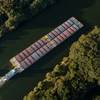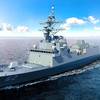Deepwater Horizon—Further proof that oil and water don’t mix
Maritime Reporter invited Carleen Lyden-Kluss, Co-Founder and Executive Director of the North American Marine Environment Protection Association to provide an overview of the Deepwater Horizon disaster in the Gulf of Mexico.
On April 20, our maritime world changed. No matter how you slice it, everyone in the maritime industry feels the effects of the tragedy; the loss of 11 lives and injury to 17 others, the extensive environmental impact, the economic fallout and ongoing costs, the exposure of weaknesses in the response system, and the regulatory changes that will result from this.
The details of the event are well known: the Deepwater Horizon oil spill, also called the BP Oil Spill/the Gulf of Mexico oil spill, is now considered the largest offshore spill in U.S. history. It has surpassed in volume the 1989 Exxon Valdez oil spill as the largest ever in U.S. territorial waters; however, it is still outranked in the greater Gulf of Mexico by the 1979 Ixtoc I oil spill. The spill emanates from a sea floor oil gusher 5,000 miles below the surface that started with an oil well blowout. The blowout caused a catastrophic explosion on the Deepwater Horizon offshore oil drilling platform that was situated about 40 miles southeast of the Louisiana coast.
Current estimates of the amount of oil being discharged range from 12,000–100,000 barrels per day, although as of this writing, the preliminary best estimate that was released on May 27 by the semi-official Flow Rate Technical Group put the volume of oil flowing from the blown-out well at “only” 12,000 to 19,000 barrels per day, which had amounted to between 440,000 and 700,000 barrels as of the date of the blowout. Obviously, as further data is collected and evaluated, the estimates will get more reliable.
In a response plan BP submitted to the U.S. Minerals Management Service (the regulatory body covering offshore drilling) as it’s “worst case scenario”, BP asserted that it could handle up to 162,000 barrels per day release, and that the chance of oil reaching the shoreline within 30 days was estimated at 3 percent or less for most coastal areas, except Louisiana's Plaquemines Parish, which the company said had a 21 percent chance of seeing oil onshore within 30 days. Clearly, this plan has proven to be optimistic rather than realistic.
The impact on the environment remains unclear, as the daily reports of oil landings, death or rehabilitation of affected fish and wildlife continues, not to mention the impact on the fisheries. While some estimates say that it will take 10 years for the event’s impact to be “flushed out”, others point to the historic Ixtoc I release and the Gulf’s survival from that event.
Dr. Quenton Dokken, Executive Director for the Gulf of Mexico Foundation summarizes it as follows:
“Oil in the Gulf of Mexico is not new – it has been entering the Gulf of Mexico for as long as the Gulf has existed:
- Natural seepage (1 -2 supertankers/year or ~1,090,910 barrels/yr)
- Marine shipping disasters (just since 1990 145,234 barrels and during WWII 56 ships were sunk in the Gulf of Mexico)
- Marine shipping operations (bilge cleaning)
- Oil/gas production (IXTOC I in 1979 3,181,818 barrels over a 10-month period)
- Chronic spills in recreational and commercial marinas (significant)
- Storm water runoff within the watershed of the Mississippi River and all other river systems feeding into the Gulf of Mexico and from coastal communities (perhaps largest source of all)
- Spills from hurricane impact (159,091 barrels during Katrina)
- Other (refinery spill 71,000 barrels)
Why is this important to know? Based on scientific measurement and history -hydrocarbons in the system have always been adequately dealt with by nature. It is not likely that the oil flowing into Gulf today will still be there a year from now. That being said, although oil and gas in the Gulf is not new, it is imperative that we reduce and eliminate human inputs where possible.
Science does not have a clue as to the total capacity of the Gulf of Mexico to absorb pollutants that we dump into it. We do not know which straw “will break the camel’s back.” Without question these human inputs can be stopped if we humans are willing to make the commitment to do so.”
While the environmental impacts are still unknown, the financial ones are easier to quantify. Since the event of April 20, BP has lost $67 billion of its market value. Further, as of this writing, the cost for cleanup to BP totals nearly $1 billion, an average of $22 million a day. It is impossible to put a price tag on the reputational cost to BP, but between the cost of the cleanup, the pending litigation, and the drop in share price has made them vulnerable to a takeover. The fishing industry is estimated to lose $2.5 billion and the Florida tourism $3 billion.
What are truly revealed by this tragic event are the weaknesses in responding to a subsea disaster. It seems our technologies are advanced in exploration and extraction, but these advances are not matched by corresponding advances in response and remediation technologies. While our capabilities to reach new depths to reach oil and gas reserves in waters over 10,000 feet deep, this event has put a spotlight on how our response to crisis is inadequate to the task of dealing in such depths. Dr. Dokken attributes that to the lack of funding for such technologies outside of military or research use.
Finally, there is Congress who must act to demonstrate their leadership in the wake of this event. The writing is on the wall that OPA 90 will be rewritten, but it is hoped that Congress will take a surgical approach, rather than treat shipping and offshore as the same entity, especially when it comes to lifting the cap on liability. As many have said, removing the cap entirely will make it impossible to insure risk.
And that is the lesson we must learn: managing risk. Perhaps it is the wrath of Poseidon that we are reminded that our environment needs our care and protection. Perhaps in our world of advanced technologies and communications we need to better evaluate our risk management procedures. As George McBundy said: “There is no safety in unlimited technological hubris.”
Carleen Lyden-Kluss is the Co-Founder and Executive Director of NAMEPA (North American Marine Environment Protection Association) leveraging off her experience as a marketing and communications professional in the commercial maritime industry with over 30 years of experience. She specializes in identifying, developing and implementing strategic marketing and communications programs that increase the visibility and effectiveness of NAMEPA.
NAMEPA is a commercial maritime industry-led organization that educates seafarers, port communities and students on the need for, and strategies for, protecting the marine environment. Founded nearly three years ago, it has grown to an international membership of over 80 companies. It has disseminated information on environmental crimes, created and distributed marine debris information, and sponsored spill response seminars in New York, San Francisco, Washington DC and Houston.
Carleen Lyden-Kluss graduated from with a BA in Political Science and History (minor in Economics) and studied Accounting at Cornell School of Business Administration. She is Executive Director of New York Maritime (NYMAR), President of the Propeller Club Chapter of the Port of New York/New Jersey, a member of the Connecticut Maritime Association, the Marine Society, intertanko, and The National Press Club, and is a trained facilitator and media trainer. She holds a USCG 100-ton Captain’s license.










